Green Supply Chain Management in India
VerifiedAdded on 2020/04/21
|9
|2412
|144
AI Summary
This assignment delves into the implementation and effectiveness of green supply chain management (GSCM) within the Indian industrial landscape. It requires students to critically examine various research articles on GSCM in India, focusing on barriers to implementation, critical success factors, and the impact of GSCM on firm performance. Students will also need to analyze different research methodologies used in these studies. The assignment emphasizes a practical understanding of GSCM challenges and opportunities specific to the Indian context.
Contribute Materials
Your contribution can guide someone’s learning journey. Share your
documents today.
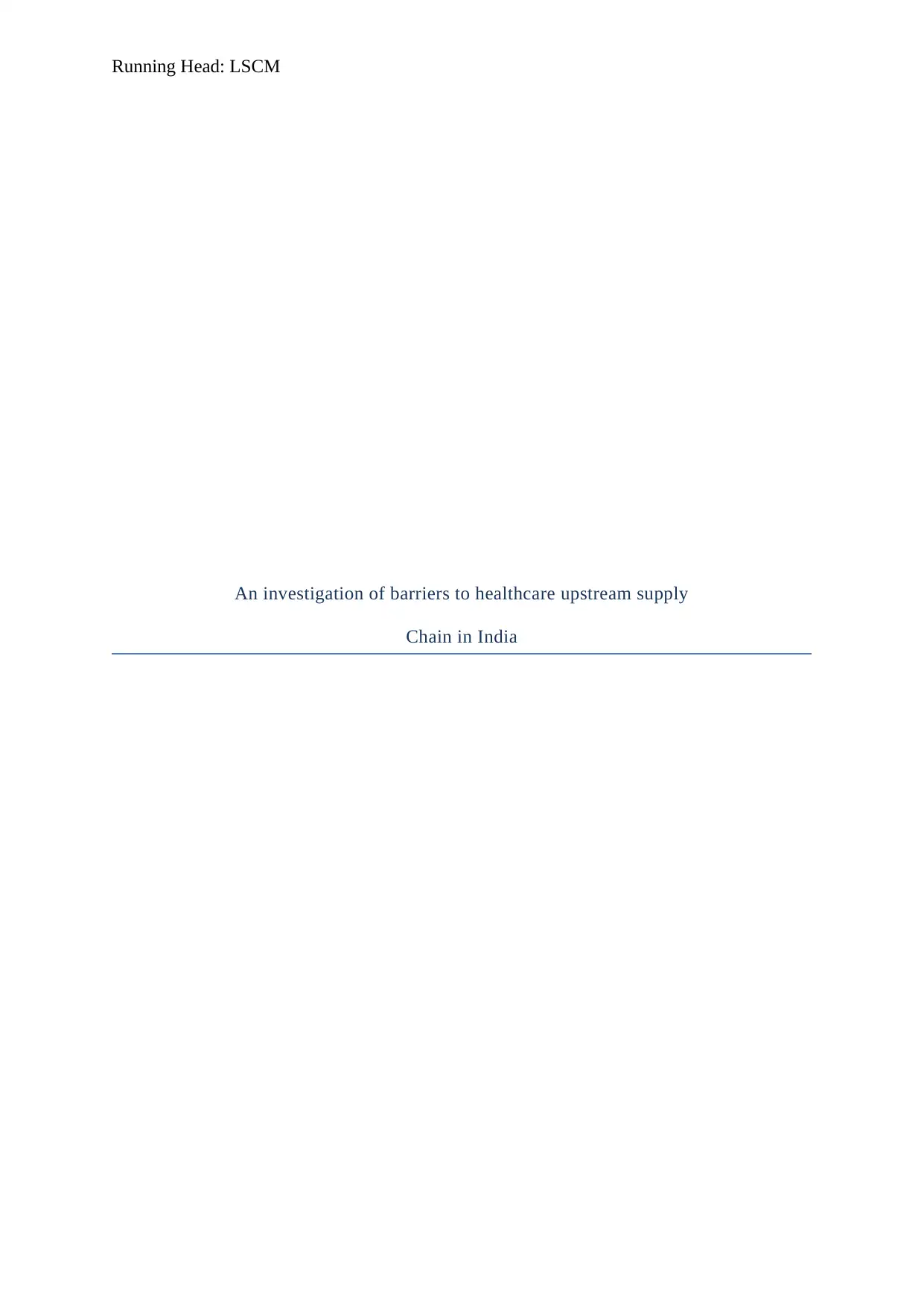
Running Head: LSCM
An investigation of barriers to healthcare upstream supply
Chain in India
An investigation of barriers to healthcare upstream supply
Chain in India
Secure Best Marks with AI Grader
Need help grading? Try our AI Grader for instant feedback on your assignments.
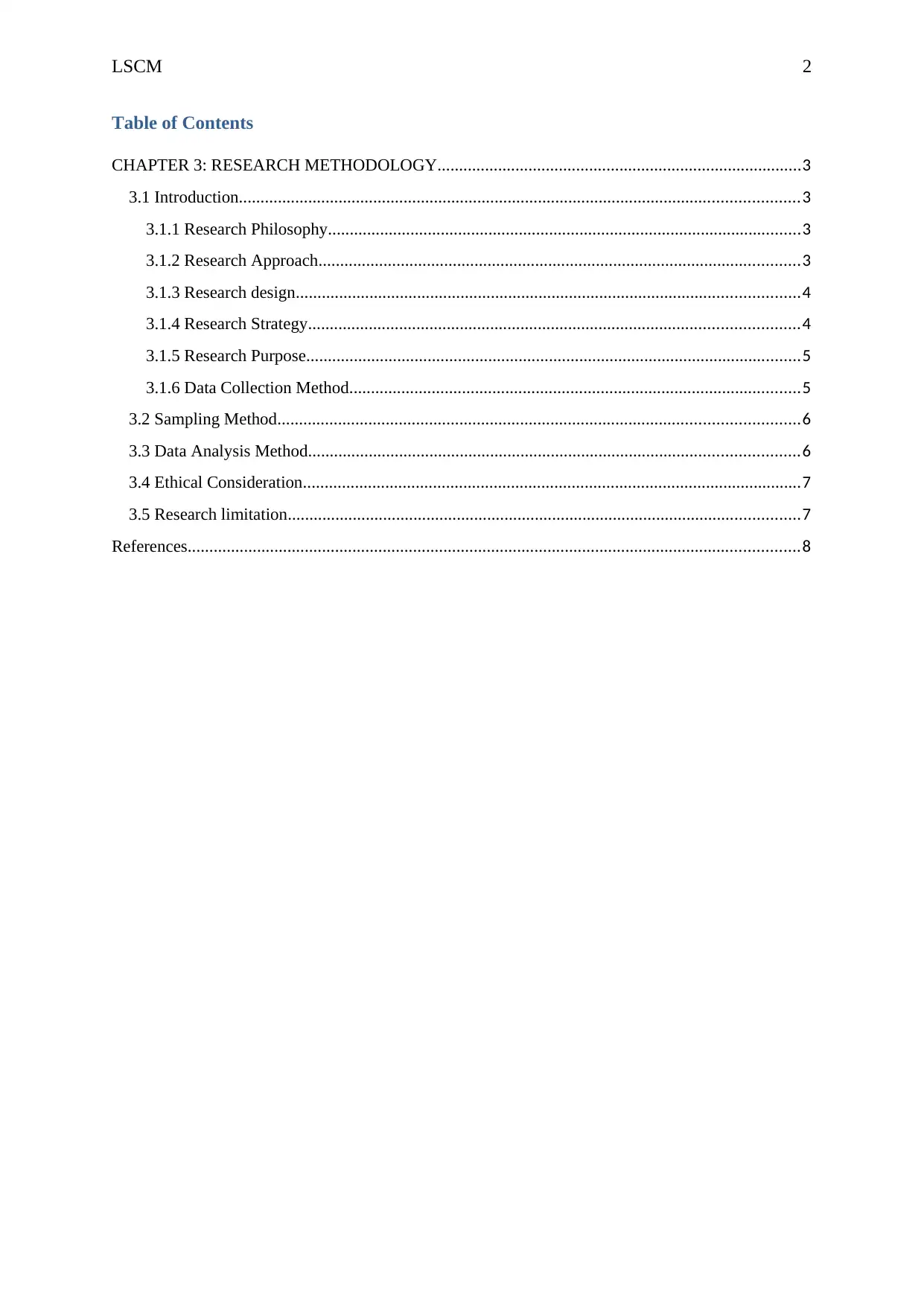
LSCM 2
Table of Contents
CHAPTER 3: RESEARCH METHODOLOGY....................................................................................3
3.1 Introduction.................................................................................................................................3
3.1.1 Research Philosophy.............................................................................................................3
3.1.2 Research Approach...............................................................................................................3
3.1.3 Research design....................................................................................................................4
3.1.4 Research Strategy.................................................................................................................4
3.1.5 Research Purpose..................................................................................................................5
3.1.6 Data Collection Method........................................................................................................5
3.2 Sampling Method........................................................................................................................6
3.3 Data Analysis Method.................................................................................................................6
3.4 Ethical Consideration...................................................................................................................7
3.5 Research limitation......................................................................................................................7
References.............................................................................................................................................8
Table of Contents
CHAPTER 3: RESEARCH METHODOLOGY....................................................................................3
3.1 Introduction.................................................................................................................................3
3.1.1 Research Philosophy.............................................................................................................3
3.1.2 Research Approach...............................................................................................................3
3.1.3 Research design....................................................................................................................4
3.1.4 Research Strategy.................................................................................................................4
3.1.5 Research Purpose..................................................................................................................5
3.1.6 Data Collection Method........................................................................................................5
3.2 Sampling Method........................................................................................................................6
3.3 Data Analysis Method.................................................................................................................6
3.4 Ethical Consideration...................................................................................................................7
3.5 Research limitation......................................................................................................................7
References.............................................................................................................................................8
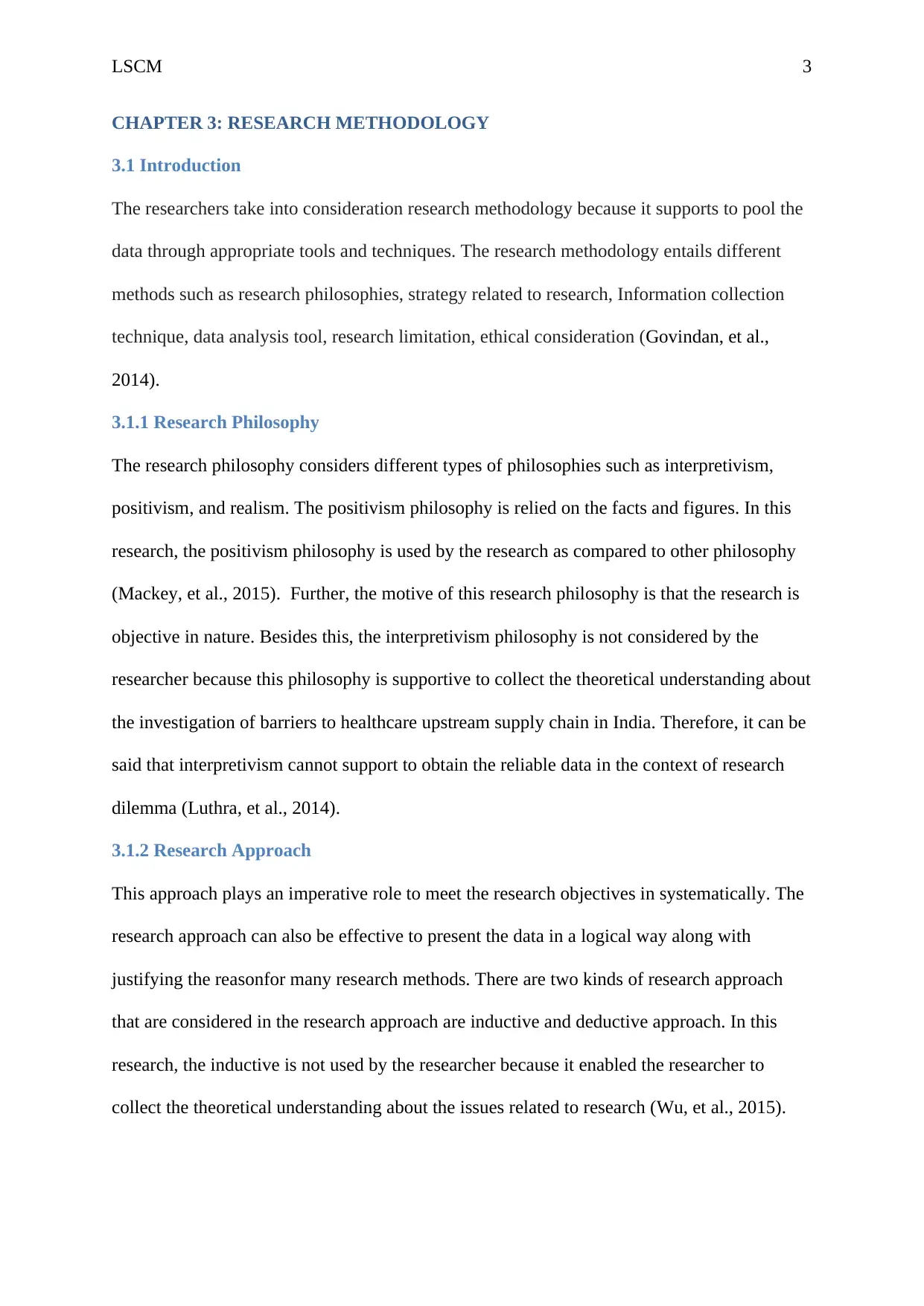
LSCM 3
CHAPTER 3: RESEARCH METHODOLOGY
3.1 Introduction
The researchers take into consideration research methodology because it supports to pool the
data through appropriate tools and techniques. The research methodology entails different
methods such as research philosophies, strategy related to research, Information collection
technique, data analysis tool, research limitation, ethical consideration (Govindan, et al.,
2014).
3.1.1 Research Philosophy
The research philosophy considers different types of philosophies such as interpretivism,
positivism, and realism. The positivism philosophy is relied on the facts and figures. In this
research, the positivism philosophy is used by the research as compared to other philosophy
(Mackey, et al., 2015). Further, the motive of this research philosophy is that the research is
objective in nature. Besides this, the interpretivism philosophy is not considered by the
researcher because this philosophy is supportive to collect the theoretical understanding about
the investigation of barriers to healthcare upstream supply chain in India. Therefore, it can be
said that interpretivism cannot support to obtain the reliable data in the context of research
dilemma (Luthra, et al., 2014).
3.1.2 Research Approach
This approach plays an imperative role to meet the research objectives in systematically. The
research approach can also be effective to present the data in a logical way along with
justifying the reasonfor many research methods. There are two kinds of research approach
that are considered in the research approach are inductive and deductive approach. In this
research, the inductive is not used by the researcher because it enabled the researcher to
collect the theoretical understanding about the issues related to research (Wu, et al., 2015).
CHAPTER 3: RESEARCH METHODOLOGY
3.1 Introduction
The researchers take into consideration research methodology because it supports to pool the
data through appropriate tools and techniques. The research methodology entails different
methods such as research philosophies, strategy related to research, Information collection
technique, data analysis tool, research limitation, ethical consideration (Govindan, et al.,
2014).
3.1.1 Research Philosophy
The research philosophy considers different types of philosophies such as interpretivism,
positivism, and realism. The positivism philosophy is relied on the facts and figures. In this
research, the positivism philosophy is used by the research as compared to other philosophy
(Mackey, et al., 2015). Further, the motive of this research philosophy is that the research is
objective in nature. Besides this, the interpretivism philosophy is not considered by the
researcher because this philosophy is supportive to collect the theoretical understanding about
the investigation of barriers to healthcare upstream supply chain in India. Therefore, it can be
said that interpretivism cannot support to obtain the reliable data in the context of research
dilemma (Luthra, et al., 2014).
3.1.2 Research Approach
This approach plays an imperative role to meet the research objectives in systematically. The
research approach can also be effective to present the data in a logical way along with
justifying the reasonfor many research methods. There are two kinds of research approach
that are considered in the research approach are inductive and deductive approach. In this
research, the inductive is not used by the researcher because it enabled the researcher to
collect the theoretical understanding about the issues related to research (Wu, et al., 2015).

LSCM 4
For this, the deductive approach is used by the researcher because it assists to gather the
general views and ideas to complete any specific task. For this method, the investigator
establishes the assumption by considering various theories and then discards and
demonstrates the analysis of data.
3.1.3 Research design
The research design can be imperative to pool the appropriate data and meet the research aim
in a systematic way. The types of methods are qualitative and quantitative information
collection method. In the study, both data collection methods are practiced by the researcher
to attain research objectives. The mixed data collection method is imperative to neglect the
drawbacks of qualitative and quantitative data collection methods (Taylor, et al., 2015).
Researcher will practice qualitative method due to getting non-numeric for meeting the aim
of research. Additionally, the quantitative research method enabled the researcher to gather
the data related to numeric regarding the issues. This study design is supportive to evaluate
the views and opinion of participants about the barriers of healthcare in supply chain
management. As a result, the researchers obtain the trustworthy and valid outcome in the
research dilemma (Mangan, et al., 2016).
3.1.4 Research Strategy
The strategy related to the study plays an imperative role in the research. It provides an
effective way to complete the task systematically. Through the research strategy, the
researcher is able to obtain the feasible result. There are different kinds of methods such as
interview, observation; case study, survey, and experiment method are considered in the
research strategy (Flick, 2015). These methods are supportive to offer appropriate data to
complete the research. In this research study, survey through questionnaire and literature
review information gathering is taken into consideration by the investigators so that the
research can be designed in logical way. The study through questionnaire method is
For this, the deductive approach is used by the researcher because it assists to gather the
general views and ideas to complete any specific task. For this method, the investigator
establishes the assumption by considering various theories and then discards and
demonstrates the analysis of data.
3.1.3 Research design
The research design can be imperative to pool the appropriate data and meet the research aim
in a systematic way. The types of methods are qualitative and quantitative information
collection method. In the study, both data collection methods are practiced by the researcher
to attain research objectives. The mixed data collection method is imperative to neglect the
drawbacks of qualitative and quantitative data collection methods (Taylor, et al., 2015).
Researcher will practice qualitative method due to getting non-numeric for meeting the aim
of research. Additionally, the quantitative research method enabled the researcher to gather
the data related to numeric regarding the issues. This study design is supportive to evaluate
the views and opinion of participants about the barriers of healthcare in supply chain
management. As a result, the researchers obtain the trustworthy and valid outcome in the
research dilemma (Mangan, et al., 2016).
3.1.4 Research Strategy
The strategy related to the study plays an imperative role in the research. It provides an
effective way to complete the task systematically. Through the research strategy, the
researcher is able to obtain the feasible result. There are different kinds of methods such as
interview, observation; case study, survey, and experiment method are considered in the
research strategy (Flick, 2015). These methods are supportive to offer appropriate data to
complete the research. In this research study, survey through questionnaire and literature
review information gathering is taken into consideration by the investigators so that the
research can be designed in logical way. The study through questionnaire method is
Secure Best Marks with AI Grader
Need help grading? Try our AI Grader for instant feedback on your assignments.
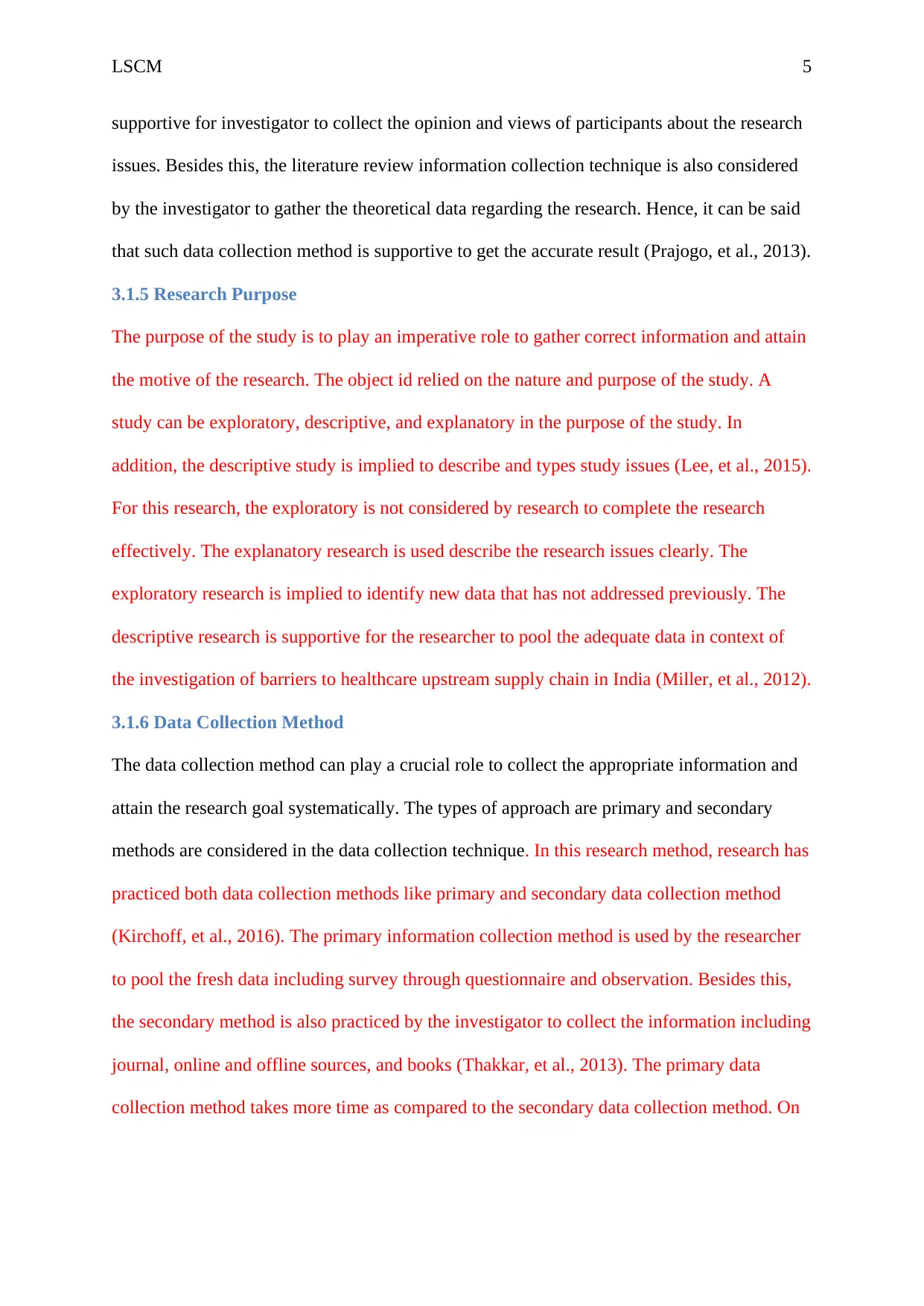
LSCM 5
supportive for investigator to collect the opinion and views of participants about the research
issues. Besides this, the literature review information collection technique is also considered
by the investigator to gather the theoretical data regarding the research. Hence, it can be said
that such data collection method is supportive to get the accurate result (Prajogo, et al., 2013).
3.1.5 Research Purpose
The purpose of the study is to play an imperative role to gather correct information and attain
the motive of the research. The object id relied on the nature and purpose of the study. A
study can be exploratory, descriptive, and explanatory in the purpose of the study. In
addition, the descriptive study is implied to describe and types study issues (Lee, et al., 2015).
For this research, the exploratory is not considered by research to complete the research
effectively. The explanatory research is used describe the research issues clearly. The
exploratory research is implied to identify new data that has not addressed previously. The
descriptive research is supportive for the researcher to pool the adequate data in context of
the investigation of barriers to healthcare upstream supply chain in India (Miller, et al., 2012).
3.1.6 Data Collection Method
The data collection method can play a crucial role to collect the appropriate information and
attain the research goal systematically. The types of approach are primary and secondary
methods are considered in the data collection technique. In this research method, research has
practiced both data collection methods like primary and secondary data collection method
(Kirchoff, et al., 2016). The primary information collection method is used by the researcher
to pool the fresh data including survey through questionnaire and observation. Besides this,
the secondary method is also practiced by the investigator to collect the information including
journal, online and offline sources, and books (Thakkar, et al., 2013). The primary data
collection method takes more time as compared to the secondary data collection method. On
supportive for investigator to collect the opinion and views of participants about the research
issues. Besides this, the literature review information collection technique is also considered
by the investigator to gather the theoretical data regarding the research. Hence, it can be said
that such data collection method is supportive to get the accurate result (Prajogo, et al., 2013).
3.1.5 Research Purpose
The purpose of the study is to play an imperative role to gather correct information and attain
the motive of the research. The object id relied on the nature and purpose of the study. A
study can be exploratory, descriptive, and explanatory in the purpose of the study. In
addition, the descriptive study is implied to describe and types study issues (Lee, et al., 2015).
For this research, the exploratory is not considered by research to complete the research
effectively. The explanatory research is used describe the research issues clearly. The
exploratory research is implied to identify new data that has not addressed previously. The
descriptive research is supportive for the researcher to pool the adequate data in context of
the investigation of barriers to healthcare upstream supply chain in India (Miller, et al., 2012).
3.1.6 Data Collection Method
The data collection method can play a crucial role to collect the appropriate information and
attain the research goal systematically. The types of approach are primary and secondary
methods are considered in the data collection technique. In this research method, research has
practiced both data collection methods like primary and secondary data collection method
(Kirchoff, et al., 2016). The primary information collection method is used by the researcher
to pool the fresh data including survey through questionnaire and observation. Besides this,
the secondary method is also practiced by the investigator to collect the information including
journal, online and offline sources, and books (Thakkar, et al., 2013). The primary data
collection method takes more time as compared to the secondary data collection method. On
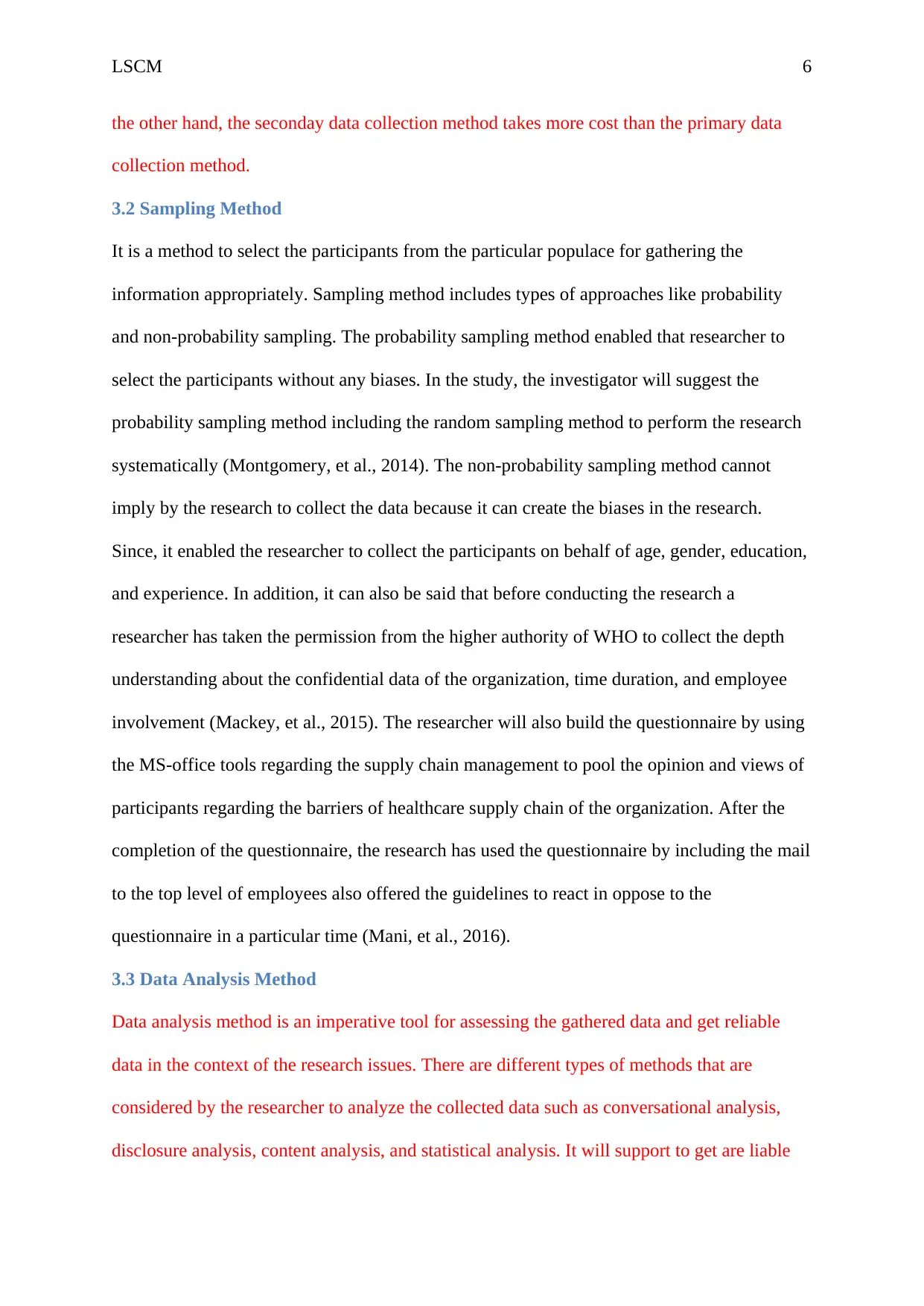
LSCM 6
the other hand, the seconday data collection method takes more cost than the primary data
collection method.
3.2 Sampling Method
It is a method to select the participants from the particular populace for gathering the
information appropriately. Sampling method includes types of approaches like probability
and non-probability sampling. The probability sampling method enabled that researcher to
select the participants without any biases. In the study, the investigator will suggest the
probability sampling method including the random sampling method to perform the research
systematically (Montgomery, et al., 2014). The non-probability sampling method cannot
imply by the research to collect the data because it can create the biases in the research.
Since, it enabled the researcher to collect the participants on behalf of age, gender, education,
and experience. In addition, it can also be said that before conducting the research a
researcher has taken the permission from the higher authority of WHO to collect the depth
understanding about the confidential data of the organization, time duration, and employee
involvement (Mackey, et al., 2015). The researcher will also build the questionnaire by using
the MS-office tools regarding the supply chain management to pool the opinion and views of
participants regarding the barriers of healthcare supply chain of the organization. After the
completion of the questionnaire, the research has used the questionnaire by including the mail
to the top level of employees also offered the guidelines to react in oppose to the
questionnaire in a particular time (Mani, et al., 2016).
3.3 Data Analysis Method
Data analysis method is an imperative tool for assessing the gathered data and get reliable
data in the context of the research issues. There are different types of methods that are
considered by the researcher to analyze the collected data such as conversational analysis,
disclosure analysis, content analysis, and statistical analysis. It will support to get are liable
the other hand, the seconday data collection method takes more cost than the primary data
collection method.
3.2 Sampling Method
It is a method to select the participants from the particular populace for gathering the
information appropriately. Sampling method includes types of approaches like probability
and non-probability sampling. The probability sampling method enabled that researcher to
select the participants without any biases. In the study, the investigator will suggest the
probability sampling method including the random sampling method to perform the research
systematically (Montgomery, et al., 2014). The non-probability sampling method cannot
imply by the research to collect the data because it can create the biases in the research.
Since, it enabled the researcher to collect the participants on behalf of age, gender, education,
and experience. In addition, it can also be said that before conducting the research a
researcher has taken the permission from the higher authority of WHO to collect the depth
understanding about the confidential data of the organization, time duration, and employee
involvement (Mackey, et al., 2015). The researcher will also build the questionnaire by using
the MS-office tools regarding the supply chain management to pool the opinion and views of
participants regarding the barriers of healthcare supply chain of the organization. After the
completion of the questionnaire, the research has used the questionnaire by including the mail
to the top level of employees also offered the guidelines to react in oppose to the
questionnaire in a particular time (Mani, et al., 2016).
3.3 Data Analysis Method
Data analysis method is an imperative tool for assessing the gathered data and get reliable
data in the context of the research issues. There are different types of methods that are
considered by the researcher to analyze the collected data such as conversational analysis,
disclosure analysis, content analysis, and statistical analysis. It will support to get are liable
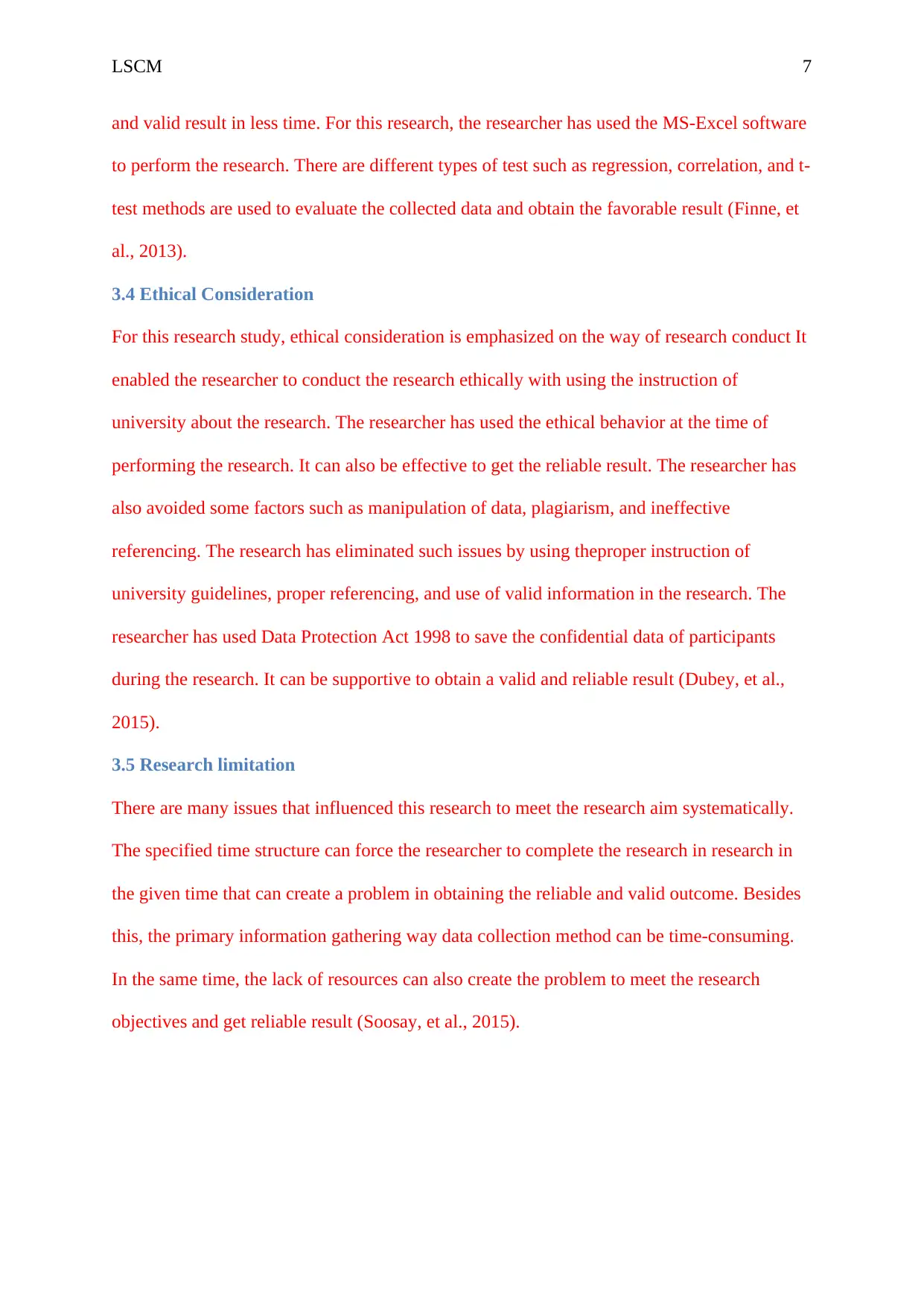
LSCM 7
and valid result in less time. For this research, the researcher has used the MS-Excel software
to perform the research. There are different types of test such as regression, correlation, and t-
test methods are used to evaluate the collected data and obtain the favorable result (Finne, et
al., 2013).
3.4 Ethical Consideration
For this research study, ethical consideration is emphasized on the way of research conduct It
enabled the researcher to conduct the research ethically with using the instruction of
university about the research. The researcher has used the ethical behavior at the time of
performing the research. It can also be effective to get the reliable result. The researcher has
also avoided some factors such as manipulation of data, plagiarism, and ineffective
referencing. The research has eliminated such issues by using theproper instruction of
university guidelines, proper referencing, and use of valid information in the research. The
researcher has used Data Protection Act 1998 to save the confidential data of participants
during the research. It can be supportive to obtain a valid and reliable result (Dubey, et al.,
2015).
3.5 Research limitation
There are many issues that influenced this research to meet the research aim systematically.
The specified time structure can force the researcher to complete the research in research in
the given time that can create a problem in obtaining the reliable and valid outcome. Besides
this, the primary information gathering way data collection method can be time-consuming.
In the same time, the lack of resources can also create the problem to meet the research
objectives and get reliable result (Soosay, et al., 2015).
and valid result in less time. For this research, the researcher has used the MS-Excel software
to perform the research. There are different types of test such as regression, correlation, and t-
test methods are used to evaluate the collected data and obtain the favorable result (Finne, et
al., 2013).
3.4 Ethical Consideration
For this research study, ethical consideration is emphasized on the way of research conduct It
enabled the researcher to conduct the research ethically with using the instruction of
university about the research. The researcher has used the ethical behavior at the time of
performing the research. It can also be effective to get the reliable result. The researcher has
also avoided some factors such as manipulation of data, plagiarism, and ineffective
referencing. The research has eliminated such issues by using theproper instruction of
university guidelines, proper referencing, and use of valid information in the research. The
researcher has used Data Protection Act 1998 to save the confidential data of participants
during the research. It can be supportive to obtain a valid and reliable result (Dubey, et al.,
2015).
3.5 Research limitation
There are many issues that influenced this research to meet the research aim systematically.
The specified time structure can force the researcher to complete the research in research in
the given time that can create a problem in obtaining the reliable and valid outcome. Besides
this, the primary information gathering way data collection method can be time-consuming.
In the same time, the lack of resources can also create the problem to meet the research
objectives and get reliable result (Soosay, et al., 2015).
Paraphrase This Document
Need a fresh take? Get an instant paraphrase of this document with our AI Paraphraser
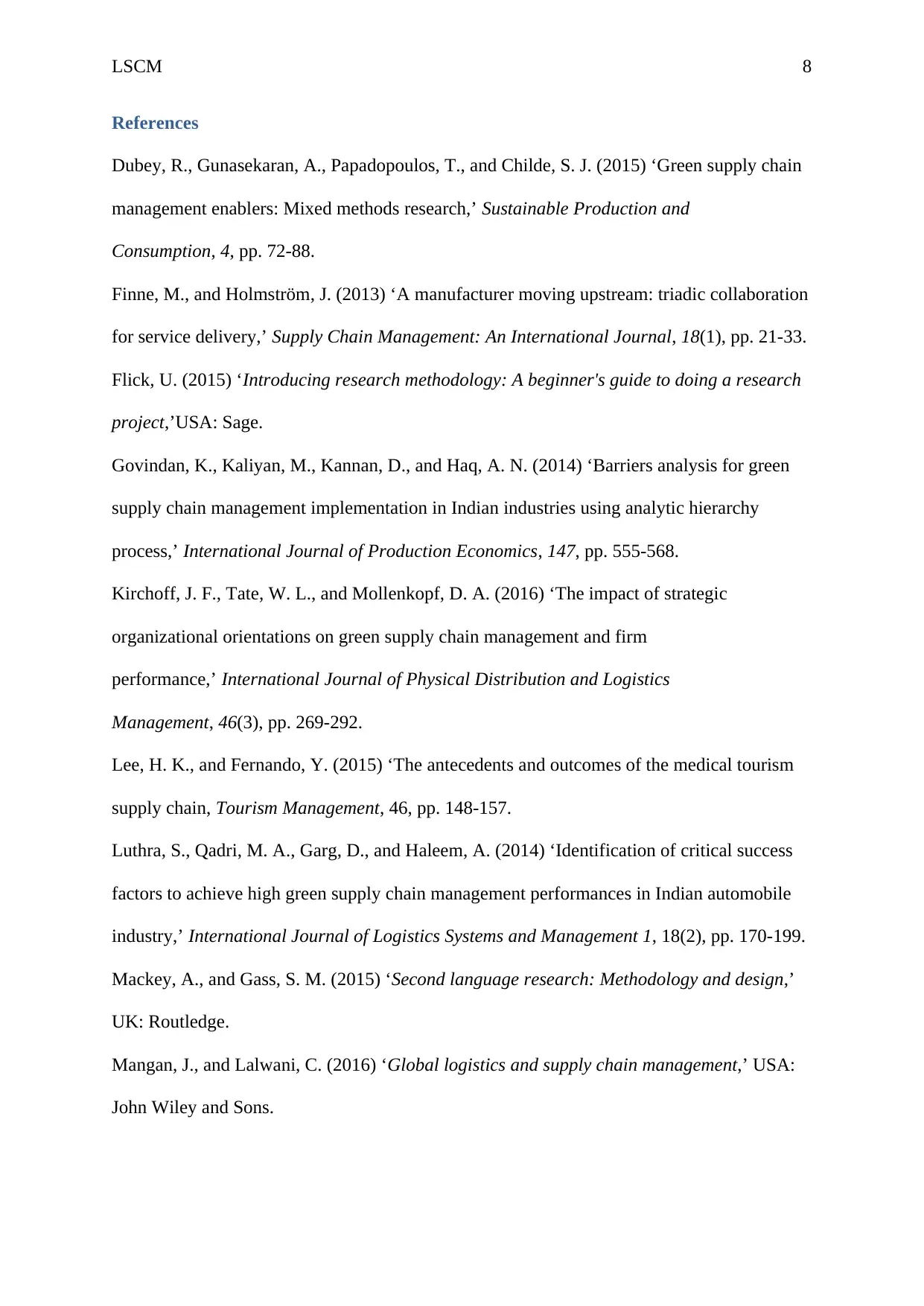
LSCM 8
References
Dubey, R., Gunasekaran, A., Papadopoulos, T., and Childe, S. J. (2015) ‘Green supply chain
management enablers: Mixed methods research,’ Sustainable Production and
Consumption, 4, pp. 72-88.
Finne, M., and Holmström, J. (2013) ‘A manufacturer moving upstream: triadic collaboration
for service delivery,’ Supply Chain Management: An International Journal, 18(1), pp. 21-33.
Flick, U. (2015) ‘Introducing research methodology: A beginner's guide to doing a research
project,’USA: Sage.
Govindan, K., Kaliyan, M., Kannan, D., and Haq, A. N. (2014) ‘Barriers analysis for green
supply chain management implementation in Indian industries using analytic hierarchy
process,’ International Journal of Production Economics, 147, pp. 555-568.
Kirchoff, J. F., Tate, W. L., and Mollenkopf, D. A. (2016) ‘The impact of strategic
organizational orientations on green supply chain management and firm
performance,’ International Journal of Physical Distribution and Logistics
Management, 46(3), pp. 269-292.
Lee, H. K., and Fernando, Y. (2015) ‘The antecedents and outcomes of the medical tourism
supply chain, Tourism Management, 46, pp. 148-157.
Luthra, S., Qadri, M. A., Garg, D., and Haleem, A. (2014) ‘Identification of critical success
factors to achieve high green supply chain management performances in Indian automobile
industry,’ International Journal of Logistics Systems and Management 1, 18(2), pp. 170-199.
Mackey, A., and Gass, S. M. (2015) ‘Second language research: Methodology and design,’
UK: Routledge.
Mangan, J., and Lalwani, C. (2016) ‘Global logistics and supply chain management,’ USA:
John Wiley and Sons.
References
Dubey, R., Gunasekaran, A., Papadopoulos, T., and Childe, S. J. (2015) ‘Green supply chain
management enablers: Mixed methods research,’ Sustainable Production and
Consumption, 4, pp. 72-88.
Finne, M., and Holmström, J. (2013) ‘A manufacturer moving upstream: triadic collaboration
for service delivery,’ Supply Chain Management: An International Journal, 18(1), pp. 21-33.
Flick, U. (2015) ‘Introducing research methodology: A beginner's guide to doing a research
project,’USA: Sage.
Govindan, K., Kaliyan, M., Kannan, D., and Haq, A. N. (2014) ‘Barriers analysis for green
supply chain management implementation in Indian industries using analytic hierarchy
process,’ International Journal of Production Economics, 147, pp. 555-568.
Kirchoff, J. F., Tate, W. L., and Mollenkopf, D. A. (2016) ‘The impact of strategic
organizational orientations on green supply chain management and firm
performance,’ International Journal of Physical Distribution and Logistics
Management, 46(3), pp. 269-292.
Lee, H. K., and Fernando, Y. (2015) ‘The antecedents and outcomes of the medical tourism
supply chain, Tourism Management, 46, pp. 148-157.
Luthra, S., Qadri, M. A., Garg, D., and Haleem, A. (2014) ‘Identification of critical success
factors to achieve high green supply chain management performances in Indian automobile
industry,’ International Journal of Logistics Systems and Management 1, 18(2), pp. 170-199.
Mackey, A., and Gass, S. M. (2015) ‘Second language research: Methodology and design,’
UK: Routledge.
Mangan, J., and Lalwani, C. (2016) ‘Global logistics and supply chain management,’ USA:
John Wiley and Sons.
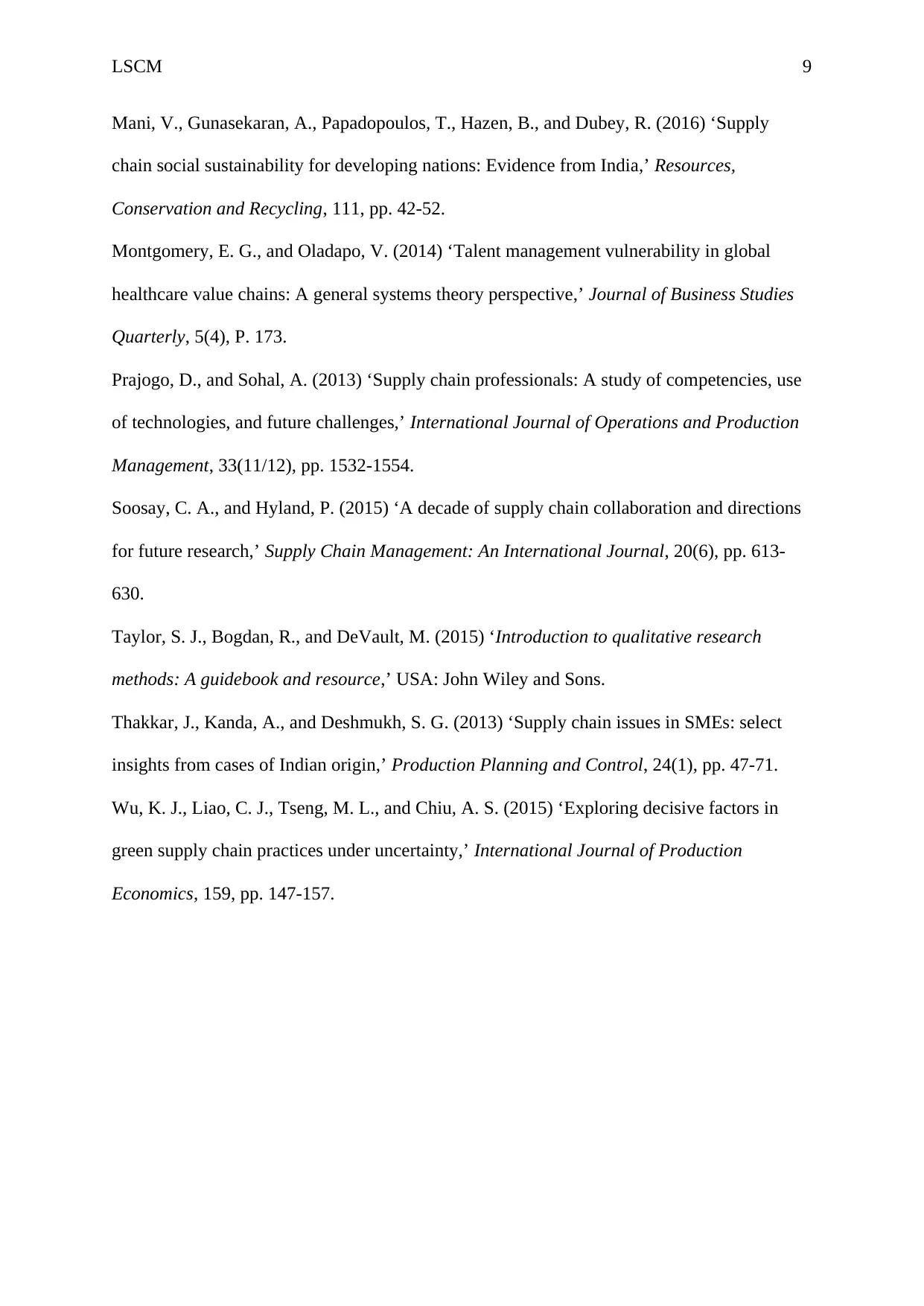
LSCM 9
Mani, V., Gunasekaran, A., Papadopoulos, T., Hazen, B., and Dubey, R. (2016) ‘Supply
chain social sustainability for developing nations: Evidence from India,’ Resources,
Conservation and Recycling, 111, pp. 42-52.
Montgomery, E. G., and Oladapo, V. (2014) ‘Talent management vulnerability in global
healthcare value chains: A general systems theory perspective,’ Journal of Business Studies
Quarterly, 5(4), P. 173.
Prajogo, D., and Sohal, A. (2013) ‘Supply chain professionals: A study of competencies, use
of technologies, and future challenges,’ International Journal of Operations and Production
Management, 33(11/12), pp. 1532-1554.
Soosay, C. A., and Hyland, P. (2015) ‘A decade of supply chain collaboration and directions
for future research,’ Supply Chain Management: An International Journal, 20(6), pp. 613-
630.
Taylor, S. J., Bogdan, R., and DeVault, M. (2015) ‘Introduction to qualitative research
methods: A guidebook and resource,’ USA: John Wiley and Sons.
Thakkar, J., Kanda, A., and Deshmukh, S. G. (2013) ‘Supply chain issues in SMEs: select
insights from cases of Indian origin,’ Production Planning and Control, 24(1), pp. 47-71.
Wu, K. J., Liao, C. J., Tseng, M. L., and Chiu, A. S. (2015) ‘Exploring decisive factors in
green supply chain practices under uncertainty,’ International Journal of Production
Economics, 159, pp. 147-157.
Mani, V., Gunasekaran, A., Papadopoulos, T., Hazen, B., and Dubey, R. (2016) ‘Supply
chain social sustainability for developing nations: Evidence from India,’ Resources,
Conservation and Recycling, 111, pp. 42-52.
Montgomery, E. G., and Oladapo, V. (2014) ‘Talent management vulnerability in global
healthcare value chains: A general systems theory perspective,’ Journal of Business Studies
Quarterly, 5(4), P. 173.
Prajogo, D., and Sohal, A. (2013) ‘Supply chain professionals: A study of competencies, use
of technologies, and future challenges,’ International Journal of Operations and Production
Management, 33(11/12), pp. 1532-1554.
Soosay, C. A., and Hyland, P. (2015) ‘A decade of supply chain collaboration and directions
for future research,’ Supply Chain Management: An International Journal, 20(6), pp. 613-
630.
Taylor, S. J., Bogdan, R., and DeVault, M. (2015) ‘Introduction to qualitative research
methods: A guidebook and resource,’ USA: John Wiley and Sons.
Thakkar, J., Kanda, A., and Deshmukh, S. G. (2013) ‘Supply chain issues in SMEs: select
insights from cases of Indian origin,’ Production Planning and Control, 24(1), pp. 47-71.
Wu, K. J., Liao, C. J., Tseng, M. L., and Chiu, A. S. (2015) ‘Exploring decisive factors in
green supply chain practices under uncertainty,’ International Journal of Production
Economics, 159, pp. 147-157.
1 out of 9
Related Documents
Your All-in-One AI-Powered Toolkit for Academic Success.
+13062052269
info@desklib.com
Available 24*7 on WhatsApp / Email
![[object Object]](/_next/static/media/star-bottom.7253800d.svg)
Unlock your academic potential
© 2024 | Zucol Services PVT LTD | All rights reserved.





